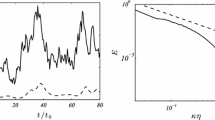Abstract
Fibre streaks are observed in experiments with fibre suspensions in a turbulent half-channel flow. The preferential concentration methods, most commonly used to quantify preferential particle concentration, are in one dimension found to be concentration dependent. Two different new streak quantification methods are evaluated, one based on Voronoi analysis and the other based on artificial particles with an assigned fixed width. The width of the particle streaks and a measure of the intensity of the streaks, i.e. streakiness, are sought. Both methods are based on the auto-correlation of a signal, generated by summing images in the direction of the streaks. Common for both methods is a severe concentration dependency, verified in experiments keeping the flow conditions constant while the (very dilute) concentration of fibres is altered. The fixed width method is shown to be the most suitable method, being more robust and less computationally expensive. By assuming the concentration dependence to be related to random noise, an expression is derived, which is shown to make the streak width and the streakiness independent of the concentration even at as low concentrations as 0.05 particles per pixel column in an image. The streakiness is obtained by applying an artificial particle width equal to 20 % of the streak width. This artificial particle width is in this study found to be large enough to smoothen the correlation without altering the streakiness nor the streak width. It is concluded that in order to make quantitative comparisons between different experiments or simulations, the evaluation has to be performed with care and be very well documented.















Similar content being viewed by others
References
Carlsson A, Håkansson K, Kvick M, Lundell F, Söderberg LD (2011) Evaluation of steerable filter for detection of fibers in flowing suspensions. Exp Fluids 51:987–996
Fessler JR, Kulick JD, Eaton JK (1994) Preferential concentration of heavy particles in a turbulent channel flow. Phys Fluids 6(11):3742–3749
Fransson JHM, Alfredsson PH (2003) On the disturbance growth in an asymptotic suction boundary layer. J Fluid Mech 482:51–90
Isermann R, Münchhof M (2011) Identification of dynamic systems. Springer, Berlin, pp. 179–200
Kaftori D, Hetsroni G, Banerjee S (1995a) Particle behavior in the turbulent boundary layer. I. Motion, deposition, and entrainment. Phys Fluids 7(5):1095–1106
Kaftori D, Hetsroni G, Banerjee S (1995b) Particle behavior in the turbulent boundary layer. II. Velocity and distribution profiles. Phys Fluids 7 (5):1107–1121
Kulick JD, Fessler JR, Eaton JK (1994) Particle response and turbulence modification in fully developed channel flow. J Fluid Mech 277:109–134
Kvick M, Håkansson K, Lundell F, Söderberg LD, Prahl Wittberg L (2012) Streak formation and fibre orientation in near wall turbulent fibre suspension flow. ERCOFTAC Bull 84:19–22
Lagraa B, Labraga L, Mazouz A (2004) Characterization of low-speed streaks in the near-wall region of a turbulent boundary layer. Eur J Mech B Fluids 23(4):587–599
Marchioli C, Fantoni M, Soldati A (2010) Orientation, distribution, and deposition of elongated, inertial fibers in turbulent channel flow. Phys Fluids 22(3):033301
Monchaux R, Bourgoin M, Cartellier A (2010) Preferential concentration of heavy particles: A Voronoï analysis. Phys Fluids 22(10):103304
Narayanan C, Lakehal D, Botto L, Soldati A (2003) Mechanisms of particle deposition in a fully developed turbulent open channel flow. Phys Fluids 15(3):763–775
Ninto Y, Garcia MH (1996) Experiments on particle wall region of an open channel flow: implications for sediment transport. J Fluid Mech 326:285–319
Pedinotti S, Mariotti G, Banerjee S (1992) Direct numerical simulation of particle behaviour in the wall region of turbulent flows in horizontal channels. Int J Multiph Flow 18(6):927–941
Rashidi M, Hetsroni G, Banerjee S (1990) Particle-turbulence interaction in a boundary layer. Int J Multiph Flow 16(6):935–949
Rouson DWI, Eaton JK (2001) On the preferential concentration of solid particles in turbulent channel flow. J Fluid Mech 428:149–169
Tagawa Y, Mercado JM, Prakash VN, Calzavarini E, Sun C, Lohse D (2012) Three-dimensional Lagrangian Voronoi analysis for clustering of particles and bubbles in turbulence. J Fluid Mech 693:201–215
Acknowledgments
Mr Joseph Fjellgren is acknowledged for the schematic drawing of the setup. This work was funded by the Knut and Alice Wallenberg Foundation, through the Wallenberg Wood Science Center. Dr. Lundell and Dr. Prahl Wittberg have also been funded by the Swedish Research Council.
Author information
Authors and Affiliations
Corresponding author
Rights and permissions
About this article
Cite this article
Håkansson, K.M.O., Kvick, M., Lundell, F. et al. Measurement of width and intensity of particle streaks in turbulent flows. Exp Fluids 54, 1555 (2013). https://doi.org/10.1007/s00348-013-1555-x
Received:
Revised:
Accepted:
Published:
DOI: https://doi.org/10.1007/s00348-013-1555-x




